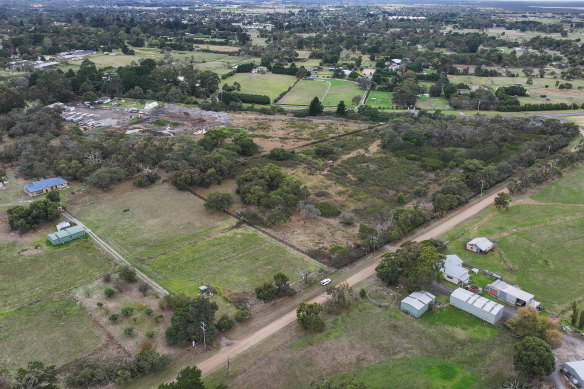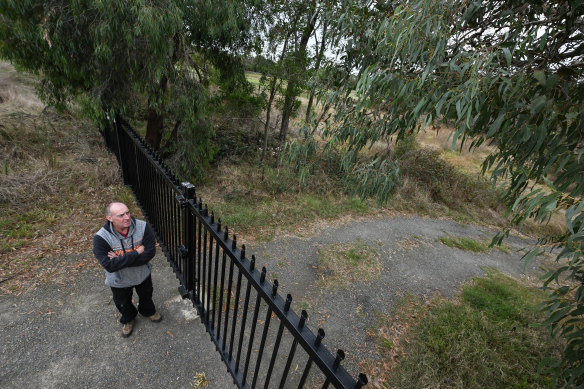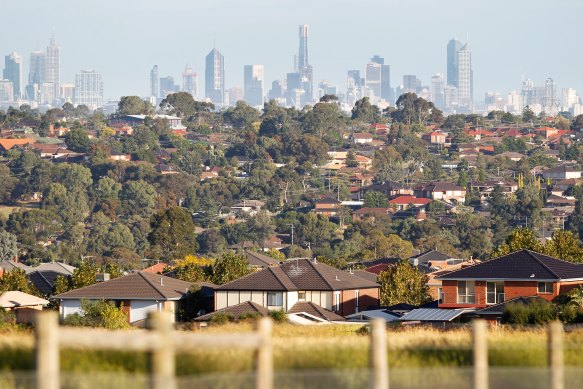By Adam Carey
Few people driving on the highway between Dandenong and Hastings south of Melbourne would find much to catch the eye as the road wends past the town of Pearcedale. Just a bush block with a metal fence around it.
But for devotees of Hindu deity Lord Sree Ayyappa Swamy, this vacant lot on a bend on the Westernport Highway has the attributes to be the perfect place to build Australia’s first traditional Keralan-style temple.

The small bush block on a bend in the highway is the subject of a VCAT dispute between residents and a religious group that seeks to build a temple there.Credit: Joe Armao
Vijay Senguttuvan is the secretary of non-profit organisation Melbourne Ayyappa Seva Sangam, which wants to build a temple on this nondescript patch of land in a rural part of the Mornington Peninsula.
“The temple is always located in a very peaceful, calming area with a good sense of vibrations,” said Senguttuvan. “This is part of our worship and part of our cultural needs, and we want to pass this tradition on to future generations, so that’s why we need this temple.”
But good vibrations have been hard to find among the locals of Pearcedale, who have joined in fierce opposition to the proposal.
“This is just so out of place; it can’t not have an effect on everyone who lives around here,” says Craig Gobbi, who lives 500 metres away from the site in the small town of Pearcedale.
Gobbi is spokesman for a residents’ group fighting to block the temple, in a clash of visions that will be heard in the Victorian Civil and Administrative Tribunal in September.
He argues the “intensity of land use” for the proposed temple, which would have capacity for 150 worshippers, is radically out of step with the neighbourhood’s agricultural character.
“We bear no ill will to the applicant or their religion, we just wish they had chosen a site that would have a less destructive effect on the environment, green wedge [and] amenity of the residents who have lived and farmed in Pearcedale for generations.”
The proposed temple is just one of several recent applications to build a place of worship or a school in a green wedge zone, that has pitted a faith-based group seeking to move into the area against an established community.

Pearcedale resident Craig Gobbi says the proposed place of worship clashes with the area’s rural character.Credit: Joe Armao
These cases are heard at VCAT, where decisions have been mixed, exposing what advocates say is a gap in planning laws that allows private interests to chip away at Melbourne’s hallowed green wedges.
Some applications have been approved such as a Steiner school in the Dandenongs, and a mosque, an Islamic school and a Catholic girls’ school, all on green wedge land in the rolling hills of Narre Warren North.
Others have failed, including a Sikh temple in Devon Meadows and a Plymouth Brethren church in Lysterfield.
Some are still in the balance, such as a proposed Buddhist temple in the Casey green wedge and a would-be Catholic boys’ school next to Lysterfield Park that has already been rejected by the City of Casey and at VCAT.
The school’s proponents have scaled back their plans and applied directly to Planning Minister Sonya Kilkenny in December, using the state’s new fast-track planning laws for non-government schools.
RMIT emeritus professor of environment and planning Michael Buxton said state laws on green wedge zones allow for a shopping list of urban uses in green wedge zones, including hotels, conference centres and schools, subject to a planning permit.
“But there is no clear policy guidance for the issuing of a permit, so what happens is councils and then VCAT have to juggle all sorts of contradictory statements,” he said.
Buxton said commercial interests were being allowed to erode the original intent of the green wedges as conceived by former premier Rupert Hamer.
“The result is we’ve now got incremental urban uses in the green wedges, which will inevitably chip away at all the values we take for granted now.”
The Allan government released its green wedges strategy in March, pledging stronger protections for farmland within 100 kilometres of central Melbourne. But the strategy includes no set guidance on schools and places of worship.
The Green Wedges Coalition argued in its submission to the strategy that schools and places of worship are “urban uses [that] rightly belong inside the Urban Growth Boundary where the students and parishioners live”.
Green Wedges Coalition coordinator Rosemary West said schools and places of worship had been approved because they are viewed as a “good use”. “But if you fill up the green wedge with ‘good uses’ we won’t have any green wedge left,” she said.

The Allan government’s green wedges strategy includes no set guidance on schools and places of worship.Credit: Paul Rovere
Melbourne’s 12 green wedge zones were conceived in the early 1970s and legislated in 2002, preserving them for non-urban uses such as farming, biodiversity and low-density activities such as airports and quarries.
But councils on Melbourne’s fringe say they are increasingly grappling with applications to build places of worship in green wedge zones, in a move driven by escalating urban property prices.
The Cardinia Shire Council, on Melbourne’s south-eastern fringe, has received nine planning permit applications and four requests to use land for a place of worship within a green wedge in the past two years.
“Our green wedge areas are increasingly receiving pressure to accommodate urban type uses,” the council said.
“One factor that is influencing this change is the difference in land prices for suitable sites for a [place of worship] are becoming increasingly difficult to find within the urban growth boundary.”
But the council baulked at its most recent meeting in March a councillor’s notice of motion seeking to introduce new guidance for community applicants applying for places of worship, opting instead to wait for direction from the state government.
An Allan government spokesperson said the government had undertaken significant work and community consultation to develop the green wedge action plan to protect farmland in and around Melbourne.
“Our Green Wedge Action Plan will help manage the potential impacts of non-urban uses of land like schools or places of worship in these areas.”
Get the day’s breaking news, entertainment ideas and a long read to enjoy. Sign up to receive our Evening Edition newsletter here.